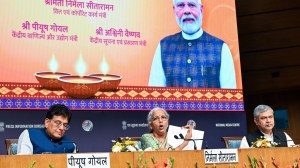Stay updated with the latest - Click here to follow us on Instagram
Khambhat farmers fight salinity ingress,soil erosion
Raju Gohil,a 33-year-old farmer,is worried that he may not be able to repay his Rs 7-lakh loan following a recent three-km long terrestrial intrusion of seawater through the Gulf of Khambhat.
Raju Gohil,a 33-year-old farmer,is worried that he may not be able to repay his Rs 7-lakh loan following a recent three-km long terrestrial intrusion of seawater through the Gulf of Khambhat.
My fields are salty. I think my crops are going to fail, says Gohil while looking at the Sabarmati estuary,not far from Vadgam village in Khambhat taluka of Anand district.
Earlier this year,the estuarys waters flowed into the surrounding farmlands,locals say,pointing out traces of it along the road connecting Vadgam with Khambhat town. In the middle of large stretches of golden bhalwheat fields are patches of fallow land,glittering white with what appears to be salt deposits.
To locals,officials and scientists alike,the area is an interesting specimen of a changing ecosystem brought about mainly by man-made activities. Salinity ingress is just one of many phenomena in this drainage basin of three rivers Sabarmati,Mahi and,further south,Narmada.
Along the coast near Vadgam,the shore is a vertical drop,more than 10 feet at some places. According to local farmers,nearly 4,000 acres of farmland have disappeared under silt and water in the last two decades.
S C Mathur,Chief Nautical Officer at the Gujarat Maritime Board,said,The northern part of the gulf is heavily silted now. Thats why all the port activities are confined to the south.
But thanks to ecologists,plantations have sprouted in the coastal areas near Tada Talav following a drive by the Gujarat Ecology Commission (GEC). Similar mangrove plantations are taking place now by the Foundation for Ecological Security (FES) with the support of Coastal Salinity Prevention Cell. Their aim is to build a natural barrier of mangroves to,one,stop the seawater and salt-laden winds from entering the fields and,two,arrest the massive erosion.
Ramesh Patel,leader of the FESs Anand team,said the heavy silting and erosion has resulted in what he calls a shifting topography. In 1991,80 hectares inside Vadgam village was totally flooded. The water here is completely unpredictable, he said.
So what is causing these changes in so short a time?
K C Tiwari,senior Professor of Geology at the MS University in Vadodara,said it is due to man-made changes in a larger ecosystem. He explained the heavy siltation throughout the gulf is due to the large-scale deforestation over decades in the Aravalli range of mountains in Madhya Pradesh and in north Gujarat and Rajasthan,where the rivers that drain in the gulf originate. Deforestation leads to heavy erosion,and the rivers carry the silt to the sea.
The salinity ingress,on the other hand,is caused by the blocking of rivers upstream by dams and barrages. As the force of the flow lessens and supply of fresh-water with it,the estuaries get increasingly dominated by salty water from the sea. The sea,one of the worlds most turbulent with tidal variations of up to 12 metres,habitually flood the flat lands along the gulf.







